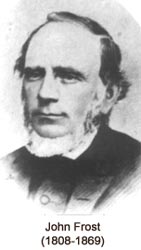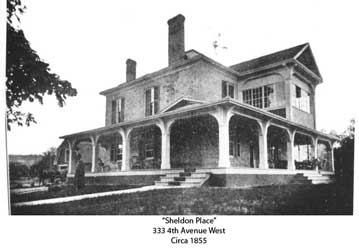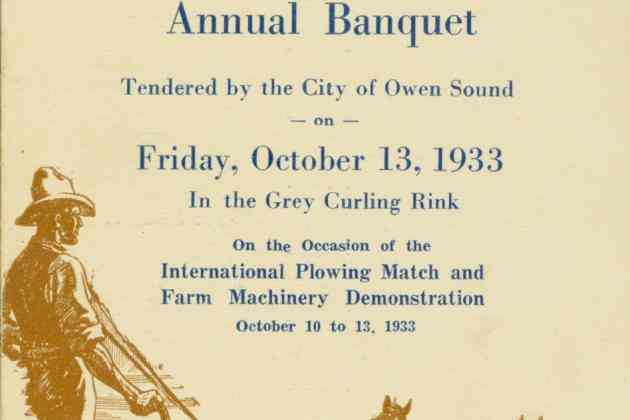John Frost and the Frost Family Story
This is the story of an extraordinary Canadian family, the John Frost Family, who in the early 1840s, discarded their comfortable, upper-middle class life in Bytown – now Ottawa – for the insecurity and uncertainty of life in the wilderness on western Georgian Bay.
The story is told, mainly, in the words of a granddaughter and a grandson.
Granddaughter, Kitty Frost Mitchell, still well-remembered in Owen Sound, (daughter of James Alexander & Mary Ann Frost), recorded her version of the family saga on audiotape in 1977 for the Owen Sound Library.
Grandson, Stanley Richard Frost, (Kitty’s cousin and youngest child of Alfred & Jane Frost) wrote a family memoir in 1965 at his home in West Hill, Ontario. Unfortunately for us, he was so modest that, although he wrote about all nine of his siblings, he recorded no details of his own life.
These two vivid accounts bring the family drama to life - not only by recounting the details of the plot but by digging deeper and searching into meaning. We are immersed in the lives lived in the community of Sydenham (Owen Sound) from the 1840s to the beginning of the 20th century – as though a reel of film were unrolling before our eyes.
In this series I have compared and contrasted each version by skipping from one to the other – from Kitty’s account to Stanley’s account - and indicating the author in each case. Occasionally, I have included pertinent information not found in either of these two family accounts, in order to set the stage and fill some gaps.
Briefly - we begin with John Frost’s forbearers. His father, John Frost Sr. (1783-1844) married Elizabeth Chic, April 7, 1806 in Sheldon in the Parish of Kentisbeare, Devonshire, England. In 1818 they migrated to Bytown in Canada bringing their son John, then 10 years old and the hero of our story, and his older sister, Mary. Family conjecture has it that the life of the landed gentry in England had blurred into a sort of dull tedium and a new and exciting start was in order.
John Frost (1808-1869), our pioneer, grew up in Bytown and married Mary Williams (1815-1903) of Welsh descent in 1833. Eventually their family grew to 9 children; 5 boys and 4 girls.
x x x x
To begin -
Stanley Richard Frost writes in his 1965 family memoir:
After the wanderlust seized him [my grandfather, John Frost] as it had his father [my great grandfather, John Frost Sr.], and in about 1844 -1845, he traveled to Owen Sound. Rumor has it that the Rev. John McDougall, a great pioneer, missionary, and buffalo hunter who had traveled the western prairies, written books, "By Saddle, Sled and Snowshoe" and "By Canoe and Dog Train" and others which I devoured as a boy, and who founded churches around the Soo and Georgian Bay told my grandfather about Huronia the land around Owen Sound, the Indians, etc.* This fired grandfather’s imagination; perhaps having a wife and five sisters to boss him around got a bit thick too – anyway off he went to look over “Huronia” – Owen Sound. He saw the rivers, the harbor, the woods and the hills so the next year he brought his wife and family to Owen Sound.
From Ottawa to Owen Sound today is about a 6 hour trip in an automobile over paved roads but in those days……………! They left by way of the Rideau Canal opened a few years before which took them to Kingston. There they got a lake boat to Toronto. There was no road from Toronto to Owen Sound then, the “Queen’s Bush” being impenetrable. So they went up Yonge Street by wagon to Holland Landing, then down to and across Lake Simcoe, down the Severn River to Georgian Bay and then by another boat to Owen Sound. It probably took several weeks to make it.
The trip across Georgian Bay was stormy. All passengers were battened below decks and as the lumber on the boat filled the hold to within a couple of feet of the deck, it was uncomfortable to say the least. I guess grandmother had thought her time had come, but when she got to Owen Sound she was welcomed by the wife of the Indian Agent who embraced her with tears of joy for the population of white women had, by her arrival, gone up to two!**
Apparently John Frost didn’t let any grass grow under his feet – he opened up a general store, and later a brickyard, a tannery, and a flour mill. During one bad winter when food supplies were low, he had the entire population, Indian and white, on rations. When the first boat sailed up the bay in the spring the whole population was at the landing, as by this time John was to the bottom of his last flour barrel.
John Frost had a feeling for the needs of the community and endeavoured to supply such needs. Store, stone quarry and a brick kiln in the beginning, and later he established a dairy because he thought the milk supply was not quite right!
Owen Sound grew rapidly, and in 1868, John Frost became mayor. In this capacity, he was also to perform the duties of magistrate. There was a predominance of Methodists within the new community with the inherent puritanical dictates. This gave rise to a famous trial. As a member of the Methodist Church, it was with great dismay that his cart and horse were seen drawing wood to the brick kiln on a Sunday.
John was fired out of the church forthwith and some of these zealots who were jealous of his success, laid an information against him, and he was brought to trial.
The court room….was crowded with local yokels. As grandfather was the magistrate, help was brought in and grandfather from the prisoner’s box, indicated how to proceed. The civil case was dismissed but he was out of the church and not a Methodist anymore.
Learning of this old case, the Rev. Wm. Hincks called the session together and John was reinstated….thirty years after his death.
When John Frost decided that he wanted to build a house, he trudged from Brooke, through the forest, almost to Inglis Falls. Going to Ottawa, he bought a team of horses, and brought them to Owen Sound, by land, by water, any way he could. The stone was quarried and brought in. It took four years to build what is known as “Sheldon Place”, located at 333 – 4th Avenue West, and this is a show-place, even today.
Stanley Richard Frost’s uncle, John William Frost, born in 1838, was the eldest of the second generation of Frosts. He was the town solicitor, a school trustee, served on County Council, and twice mayor of Owen Sound.
John William authored “Broken Shackles – Old Man Henson from Slavery to Freedom”, originally published under the pseudonym “Glenelg”. It is likely that young Frost listened to stories of the Black residents of the town, and it is known that the grandfather sheltered runaway Blacks on his property.
Third son of John Frost, Alfred John, father of Stanley Richard, was Crown Attorney and Local Master of the Supreme Court, as well had a family of ten children. In approximately 1890 he had constructed a large home at 313 – 2nd Avenue East, which ultimately became the Children’s Aid residence.
Alfred John Frost built an early example of a gasoline propelled vehicle. This was about 1900. The body was composed of a fancy surrey (built by Mr. Rutherford, a carriage builder), and Alfred (Fred) installed the two cylinder engine, drive, steering apparatus, etc.
In the second generation, from Stanley Richard’s memoir:
Mother, Jane Greene deserves a whole paragraph. Father died …. 5l years old, and mother was faced with the job of raising a large family. All through she radiated sunshine and liked to sing. Singing on Sunday mornings as she prepared breakfast in the kitchen, “Safely Through Another Week” and “He Leadeth Me. All were educated and well fed.
In the third generation of Frosts, some of the women became nurses (Minnie) and teachers (Mary, Ethel, Helen, Alberta) and librarians (Jennie, Bertha). The family became scattered – Toronto, Kingston, Claresholm, Fort William, Winnipeg, Portage La Prairie, Calgary, Plumas, Indian Head and Grand Prairie in Canada.
In the days of the first settlers in this region, opportunities were limitless in a way which is difficult to grasp today. John and Mary Frost, then their children and grandchildren, expressed their humanity and their talents freely and vigorously. They were leaders who sought the good for their town/city. They were abolitionists (of slavery) who acted on their convictions. They responded viscerally to the beautiful world of Georgian Bay. They valued education for their children and sent them out into the world as contributors. Lastly, they left us a beautiful stone house on a hill (Sheldon House) – a permanent legacy to the people of Ontario and indeed, the people of Canada.
*ed. note: George McDougall, father of John, may in fact have been the subject of the rumour; John McDougall was born in 1842 in (what is now) Owen Sound.
** The Indian Agent for this area in the 1840s was Capt. Thomas G. Anderson, who was assigned to the Central Superintendency and travelled from post to post. There was no resident Indian Agent. Mr. Frost may be referring to Elizabeth McDougall, as George performed unofficial missionary work amongst local First Nations people.











